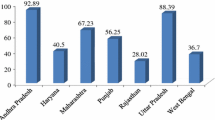Abstract
The economic benefits of insect-resistant genetically modified (GM) crops have been well documented, but the impact of such crops and the consequent reduction in pesticide use on farmers’ health remains largely unknown. Through the analysis of the data collected from the physical examination from farmers in China, we show that GM rice significantly reduces pesticide use and the resultant not only visible but also invisible adverse effects on farmers’ neurological, hematological, and electrolyte system. Hence, the commercialization of GM rice is expected to improve the health of farmers in developing countries, where pesticide application is necessary to mitigate crop loss.
Article PDF
Similar content being viewed by others
Avoid common mistakes on your manuscript.
References
Huang J, Hu R, Rozelle S, Pray C. Insect-resistant GM rice in farmers’ fields: assessing productivity and health effects in China. Science, 2005, 308: 688–690
Pray C, Ma D, Huang J, Qiao F. Impact of Bt cotton in China. World Dev, 2001, 29: 813–825
James C. Global Status of Commercialized Biotech/GM Crops: 2012, ISAAA Brief No. 44, Ithaca, NY, 2001
Huang J, Qiao F, Zhang L, Rozelle S. Farm pesticide, rice production, and the environment. Economy and Environment Program for Southeast Asia (EEPSEA) Res, Rep. 2001-RR3, International Development Research Center, Singapore, 2001
Hossain F, Pray C, Lu Y, Huang J, Fan C, Hu R. Genetically modified cotton and farmers’ health in China. Int J Occup Environ Health, 2004, 10: 296–303
Pingali P, Hossain M, Gerpacio R. Asian Rice Bowls-The Returning Crisis? Wallingford: CABI Publishing, 1997
Bjørling-Poulsen M, Andersen H, Grandjean P. Potential developmental neurotoxicity of pesticides used in Europe. Environ Health, 2008, 7: 50–71
Pingali P, Marquez C, Palis F. Pesticides and Philippine rice farmer health: a medical and economic analysis. Am J Agricult Econ, 1994, 76: 587–592
Deng C, Song G, Xu J, Zhu Z. Increasing accumulation level of foreign protein in transgenic plant through protein targeting. Acta Bot Sin, 2003, 45: 1084–1089
Eddleston M, Buckley N, Eyer P, Dawson A. Management of acute organophosphorus pesticide poisoning. Lancet, 2008, 371: 597–607
Qiao F, Huang J, Zhang L, Rozelle S. Pesticide use and farmers’ health in China’s rice production. China Agricult Econ Rev, 2012, 4: 468–484
Chen X, Xu L, Du J, Lv C, Zhang Z, Zhou Y, Qi K. The clinical meaning of testing serum NSE of acute organophosphorus pesticides poisoning children. Military Med J Southeast China, 2011, 13: 310
Wang X, Zhang G. Clinical change of red blood cell and its implications of the acutely organophosphates poisoned patients. Chin J Misdiag, 2007, 7: 966
Liu H, Wang J, Yang Y, Hou J. Clinical change of neuter granulocyte percentage in blood and its implications of the acutely organophosphates poisoned patients. Chin J Crit Care Med, 2003, 23: 364–365
Bai B, Gao M, Su L, Zhou X. Physiology, version 6. Beijing: People’s Medical Publishing House, 2009
Logaswamy S, Radha G, Subhashini S, Logankumar K. Alterations in the levels of ions in blood and liver of freshwater fish, Cyprinus carpio var. communis exposed to dimethoate. Environ Monitor Assess, 2007, 131: 439–444
Eisler R, Edmunds P. Effect of endrin on blood and tissue chemistry of a marine fish. Trans Am Fish Soc, 1966, 95: 153–159
Grant B, Mehrle P. Chronic endrin poisoning in gold fish, Carassius auratus. J Fish Res Board Canada, 1970, 27: 2225–2232
National Bureau of Statistics of China. China Statistical Yearbook. Beijing: China Statistics Press, 2012a
National Bureau of Statistics of China. Fujian Statistical Yearbook. Beijing: China Statistics Press, 2012b
Landis A, Wratten D, Gurr M. Habitat management to conserve natural enemies of arthropod pests in agriculture. Ann Rev Entomol, 2000, 45: 175–201
Gardiner M, Landis A, Gratton C, DiFonzo D, O’Neal M, Chacon M, Wayo T, Schmidt P, Mueller E, Heimpel E. Landscape diversity enhances biological control of an introduced crop pest in the north-central USA. Ecol Appl, 2009, 19: 143–154
Zhou K, Huang J, Deng X, van der Werf W, Zhang W, Lu Y, Wu K, Wu F. Effects of land use and insecticides on natural enemies of aphids in cotton: first evidence from smallholder agriculture in the North China Plain. Agricult Ecosyst Environ, 2014, 183: 176–184
National Development and Reform Commission. The National Data on the Cost and Revenue of Agricultural Commodities. Beijing: China Statistics Press, 2012
Author information
Authors and Affiliations
Corresponding authors
Additional information
This article is published with open access at link.springer.com
Rights and permissions
Open Access This article is distributed under the terms of the Creative Commons Attribution 2.0 International License (https://creativecommons.org/licenses/by/2.0), which permits unrestricted use, distribution, and reproduction in any medium, provided the original work is properly cited.
About this article
Cite this article
Huang, J., Hu, R., Qiao, F. et al. Impact of insect-resistant GM rice on pesticide use and farmers’ health in China. Sci. China Life Sci. 58, 466–471 (2015). https://doi.org/10.1007/s11427-014-4768-1
Received:
Accepted:
Published:
Issue Date:
DOI: https://doi.org/10.1007/s11427-014-4768-1




